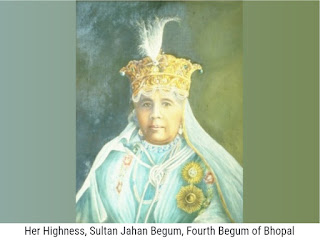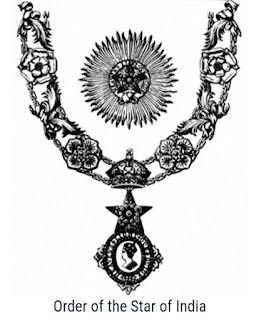To have four Muslim women successively rule a state is unprecedented in world history. What makes it all the more remarkable is that these women administered a state dominated by feudal warlords accustomed to male privilege over the throne. Between 1819 and 1926, four brave women ruled over the princely state of Bhopal. These were Kudsia Begum (1819-37), Sikander Begum (1847-68), Shah Jahan Begum(1868-1901) and Sultan Jahan Begum (1901-1926).
Nazarana rupee, Shah Jahan Begum
The modern city of Bhopal was founded in 1707 by Dost Mohammad Khan, an Orakzai Pathan from Afghanistan, and it soon became the second-most important Muslim princely state after Hyderabad.
Location of Bhopal in a map of India, 1700-1792
It all started with Kudsia Begum,
Kudsia's or Gohar's reign began when she stood up in front of the congregation at her husband's soyen (post-death ritual), (after her husband was assassinated) and said that her 15-month-old daughter is the rightful heir. Her taking off her veil before she spoke, at the age of 18, although she was brought up traditionally, dared to take congregation of elders, rivals, contenders, state officials by the scuff of their necks, and this was unprecedented.
Although she was illiterate, she was brave and refused to follow the purdah tradition. She cared very well for her subjects and took her dinners only after receiving news every night that all her subjects had taken meals. She built the Jama-Masjid of Bhopal and her palace, 'Gohar Mahal.'
Kudsia Begum retired from the administrative affairs of Bhopal with a grant of 5 lakhs per annum. In 1877, she was decorated with the Order of the Imperial Cross. She passed away at the age of 82 and bequeathed her personal property to her granddaughter Shah Jahan
Sikander Begum ruled as a regent for the first 13 years, standing in for her nine-year-old daughter Shahjahan and then as a ruler for the next eight years.
Sikander Begum was a woman of diminutive stature but with the most imperious gaze. Her husband died in 1844. She was proud of her Afghan ethnicity and refused to go into Purdah. Her education and physical activities were at par with other male rulers. She was a practiced horsewoman and participated in polo games and hunting. She was trained in martial arts and could equally wield a bow, a sword or a lance. Her 21 years reign qualifies as the golden age of Bhopal's history.
Sikander Begum gave birth to a girl named Shah Jahan Begum in July 1838.
Shah Jahan Begum (1868-1901)
The British government recognized the succession of Shah Jahan Begum and proclaimed her the chief of the state in April 1845. Her mother Sikander Begum was appointed as regent. The regent queen spearheaded many policies for the betterment of her subjects. In 1845, a medical department was set up. She allied with the British during the First war of Independence in 1857 and suppressed mutinies at several places. She urged that she should be regarded as the ruler of Bhopal and not the Regent. In 1860, Sikander Begum was recognized as the chief of Bhopal. In 1861, the Begum was given the highest Order of the Star of India at Allahabad. She died in 1868 at the age of 51.
Shah Jahan Begum, Sikander's daughter was invested as the ruler in 1868. She was married to the commander-in-chief of the state. In her reign she founded 76 primary schools and two girls schools. Her interest in architecture is indicated by projects such as the Taj-ul-Masjid mosque and construction of railway line between Hoshangabad and Bhopal.
Unlike her mother and grandmother, Shahjahan was distinctly feminine. She did not train in masculine arts as a fighter and instead was keen in arts. She was a very strong administrator.
In 1871, she married Maulvi Sayad Sidiq Hussain. After her second marriage, she retired behind Purdah. For her accomplishments, she was made Knight Grand Commander in 1872. She died in 1901 and was succeeded by her daughter Sultan Jahan Begum.
Sultan Jahan Begum (1901-1926)
Sultan Jahan Begum was born in 1858. At 43 years, she was the oldest Begum of Bhopal. She was also called "Sarkar Amma". Her years as the heir were spent in immense difficulty due to her tension with her mother. By the time of her reign, the court was divided in loyalty between Sultan Jahan and her mother. She further advanced the emancipation of women and established a modern municipality in 1903. She had her own palace Sadar Manzil, the present headquarters of Bhopal Municipal Corporation
In 1905, Sultan Jahan Begum met the Royal Highnesses, the Prince and Princess of Wales at Indore and was given the Order of Chivalry, Knight Grand Commander.
She conducted administration of the state with her eldest son, Nawab Muhammad Nasr-ul-lah Khan. She attended George V coronation, dressed in a Burqa with her awards worn on the outside. In 1914, she became President of the All-India Muslim Ladies Conference. In 1918, she founded the All-India Ladies Association. She along with her mother provided financial support for the preservation of the Buddhist Stupa at Sanchi as also funded the Archeological Museum built there in 1919. Her greatest legacy is the Aligarh Muslim University, built in 1920. She was the founding, Chancellor. She died in 1930.
She abdicated the throne to her son, Muhammad Hamid-ul-lah Khan.
Thus, after a century of women regents and after her insistence, the British agreed. He was the last ruling Nawab of Bhopal.
Of his three daughters, Abida Sultan, the rightful successor lost the right by migrating to Pakistan. So stepped in his second eldest daughter Sajida Sultan was married to Iftikhar Ali Khan Pataudi, and their son was Mansoor Ali Khan Pataudi, the famous cricketer. Abida Sultan's son was Pakistan foreign secretary Shaharyar M Khan. Incidentally, Dr Abdul Qadeer Khan is also from the same family.
The state merged with Madhya Pradesh in 1956





















Amazing Historical learning through the coins if Gen Rajeev Sharma.
ReplyDelete